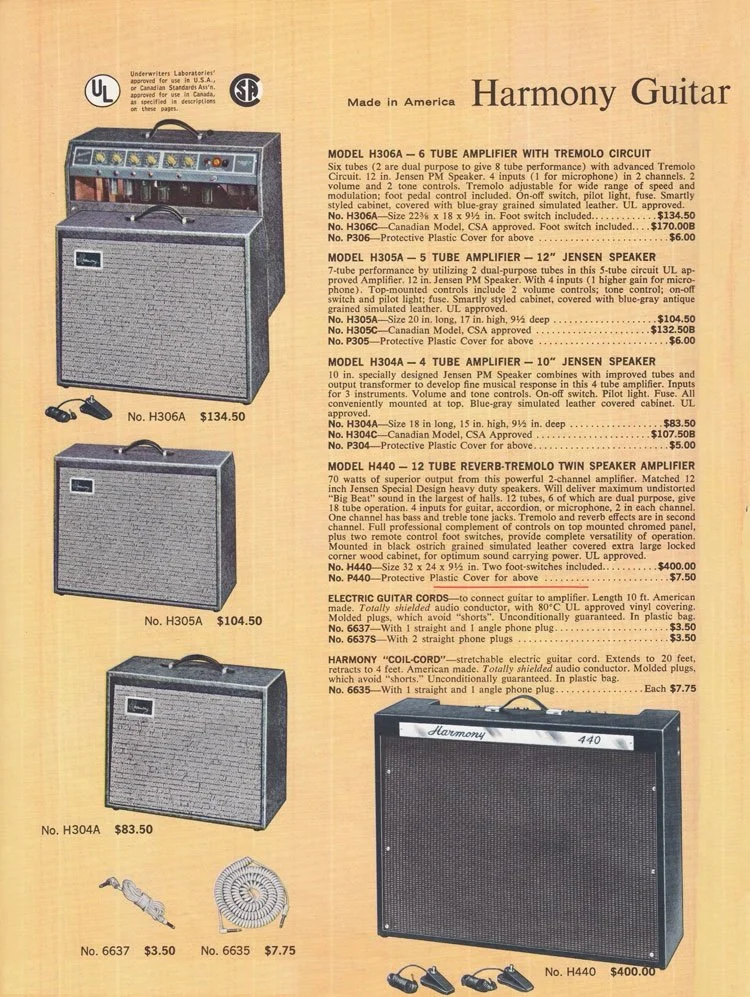Rediscovering Vintage: The Harmony H305c
Back in late 2022, I came into possession of a Harmony H305c, and I have to tell you that this thing rocks! It is effectively a Fender Tweed Deluxe (5E3 circuit), but you can still buy these at relatively low prices! As of the writing of this blog in January 2023, they are priced on the used market between $300 and $400. For the sake of comparison, I encourage you to do a quick Google search for the current price of a vintage Tweed Deluxe — or even a reissue for that matter.
Series
So what’s the deal with this amp? Well, it is a combo amp that was part of Harmony’s early 1960’s amp line that was sold through their (by then) parent company, Sears, Roebuck & Co. As you can see from the advertisement below, the H305c was the Canadian version of the H305A. I would love it if someone out there could provide a bit more information about how the “CSA Approved” aspect of this amp might differ from its American brother!
Manufacturing History
While the Harmony H305c has the labeling of the Harmony company, this amp (as well as the other amps in the same line) were manufactured under contract by the Sound Projects Company. The Sound Projects Company was another Chicago-based musical instrument manufacturer like Harmony, but the Sound Projects Company was most known for its proprietary brand of Lectrolab, which was primarily (but not exclusively) applied to their amplifiers.
At the time of the manufacturing of the H305c, the Sound Projects Company was making its own Tweed Deluxe-styled circuit in the Lectrolab R500B. This amp became the foundation upon which the H305c was built. The Lectrolab R500B had three iterations (the A, B, and C), but it is the B that is the closest to the H305c.
What is Under the Hood?
As you can read in the copy from the advertisement above, this amp came with five tubes and a 12” Jensen speaker. The five tubes are as follows: two (2) 12AX7 tubes, two (2) 6V6 tubes, and one (1) 5Y3 rectifier tube.
The control panel includes four inputs that feed into two different channels (two inputs for each channel). Each channel has its own volume control, and there is a single tone control. The tone control was set up in such a way as to blend a treble bypass cap and a treble cut cap which are both connected to the volume control as well. This means that as you turn the volume down, the treble cut cap rolls off the treble at lower frequencies while the treble also increasingly ignores the volume control via the bypass cap. All of this means that while the bass would seem to maintain regardless of where the tone control and volume are set, the treble fluctuates as to create an overall varying EQ balance that responds to both the volume and tone control knobs.
The cabinet of the amplifier is likely the weak point of this model; it is something akin to particle board. So, while it is lightweight, it can be quite weak around the corners.
Why Bother with This Amp?
As stated above, you are looking at an amp that was closely based upon and built just a few years after the original Fender Tweed Deluxe 5E3 amps hit the market. However, these things are coming in at a price that is lower than some of the modern guitar pedals out there trying to give you an “authentic Tweed Deluxe sound.”
While a vintage amp such as this might not be a great touring or even live option, as a studio tool this thing is tough to beat. From clean tones to completely nasty overdrive, I really cannot find a bad setting with this amp. I would encourage anyone who is looking for this sound at their home or in their recording space, do not sleep on these!

